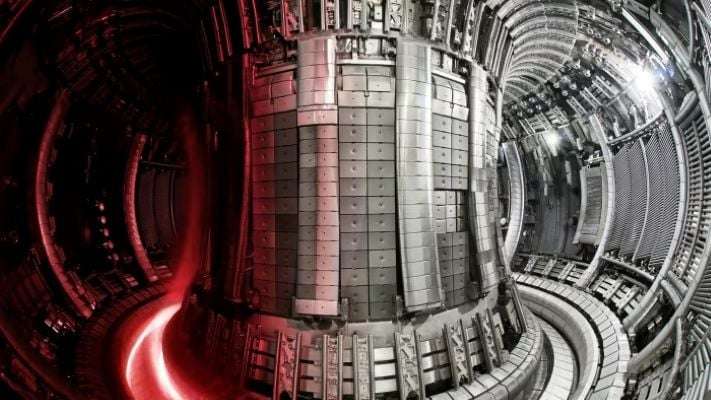Introduction: A New Era of Clean Energy
In a groundbreaking announcement on Tuesday, Commonwealth Fusion Systems (CFS) revealed plans to build the world’s first commercial fusion energy power plant in Chesterfield County, Virginia. This multi-billion-dollar project marks a significant milestone in the pursuit of sustainable, clean energy solutions. The fusion power plant is set to be constructed at Dominion Energy’s James River Industrial Complex, a key location that will play a central role in reshaping the future of energy generation.
The fusion plant aims to replicate the process that powers the sun and stars. Using nuclear fusion, it promises a new era of energy that is both clean and abundant. CFS’s ambitious project is poised to transform the energy landscape, bringing a solution that could significantly reduce humanity’s dependence on fossil fuels.
What is Fusion Energy?
Fusion energy refers to the process by which two atomic nuclei combine, or fuse, to form a heavier nucleus, releasing enormous amounts of energy in the process. This is the same reaction that powers stars, including our own Sun. Unlike fission, the process used in current nuclear reactors, fusion does not produce hazardous waste and is far safer.
According to Alex Creely, Chief Engineer at CFS, “Fusion is what powers the stars, and we are basically trying to build a star here on Earth and use it to make electricity.” This analogy of building a star on Earth helps the public grasp the vast potential of fusion energy in terms of scale and impact.
Project Overview: The Future of Clean Power in Chesterfield
The proposed fusion plant will be located in Chesterfield County, Virginia, specifically within the Dominion Energy’s James River Industrial Complex. The plant will leverage a tokamak, a doughnut-shaped machine that uses powerful magnets to contain the fusion reaction. The plant is designed to generate 400 megawatts of net electricity, which is sufficient to power approximately 150,000 homes for over 20 years.
The project, which is expected to create hundreds of jobs, is hailed as a revolutionary step towards clean energy production. The fusion reaction in this tokamak will be able to generate vast amounts of energy without the harmful byproducts associated with fossil fuels.
Key Features of the Fusion Power Plant
1. Safe and Clean Energy Generation
One of the most significant aspects of fusion energy is its inherent safety. Unlike traditional nuclear fission reactors, fusion reactions stop automatically if exposed to air, eliminating the risk of meltdowns. Bob Mumgaard, the co-founder and CEO of CFS, emphasized the importance of safety in the process, noting that fusion is a much cleaner and safer alternative to current energy production methods.
2. A Sustainable Solution for the Future
This fusion plant is a step towards providing clean energy to hundreds of thousands of homes. The plant’s output of 400 megawatts will be used to supply energy to the PJM power grid. As the project advances, it will serve as a template for future fusion power plants around the world, which could help meet the growing demand for energy, especially in developing nations.
3. Investment and Community Support
The state of Virginia, along with Chesterfield County, has pledged significant investment in the project. Governor Glenn Youngkin reassured residents that the project would not result in increased rates for Dominion Energy customers. In total, Virginia and Chesterfield County are investing $12 million into the project, underscoring the importance of the plant in boosting the local economy and advancing energy technology.
Fusion Power: A Game-Changer for the Energy Industry
The development of commercial fusion power plants has long been considered a dream technology that could address several of the world’s energy challenges. Fusion power offers numerous advantages over traditional energy sources:
- Clean Energy: No harmful greenhouse gases or radioactive waste.
- Abundant Fuel: Fusion reactions rely on hydrogen isotopes, which are abundant and easy to obtain.
- Safety: Unlike fission reactors, fusion plants are not prone to dangerous meltdowns.
- Scalability: Fusion plants could provide scalable, sustainable energy solutions for regions worldwide.
Adam Stein, Director of the Nuclear Energy Innovation program at the Breakthrough Institute, explained that while the commercialization of fusion energy will take time, it holds immense potential for a cleaner, sustainable energy future. The first-generation fusion plants will likely face challenges, including high costs and technical hurdles, but they represent a crucial first step toward widespread adoption.
Technological Innovation: The Role of Tokamak in Fusion Energy
The core of the fusion power plant’s design is the tokamak machine. This innovative technology is responsible for confining the plasma needed to sustain the fusion reaction. The tokamak uses powerful magnetic fields to create a controlled environment where the fusion process can take place.
CFS’s tokamak aims to generate 400 megawatts of electricity while maintaining a safe and stable environment for the process. This is a significant achievement in fusion energy, as the goal of many scientists is to achieve a stable, net-positive energy output from fusion reactions.
Benefits for the Local Community
Beyond its environmental impact, the fusion power plant is expected to benefit the local community in several ways:
1. Job Creation
The construction and operation of the plant will create hundreds of local jobs, from engineers and scientists to construction workers and administrative staff.
2. Economic Growth
The project will bring long-term economic benefits to Chesterfield County and Virginia, especially with the state’s investment and the $10 million pledged by the county for future advancements.
3. A Safe and Sustainable Future
The fusion plant’s ability to generate clean energy without environmental harm aligns with the region’s goals for sustainability and energy innovation.
Looking Ahead: The Future of Fusion Energy
The Chesterfield fusion plant represents a significant leap forward for fusion energy. However, there is still much work to be done. As fusion technology evolves, future fusion plants will become more efficient, cost-effective, and scalable. These advancements will be critical in shaping the global energy landscape and ensuring a sustainable energy future for generations to come.
As CFS and other energy innovators continue to develop and refine fusion energy, the world may be on the brink of a major energy revolution.
FAQs
1. What is fusion energy?
Fusion energy is the process by which atomic nuclei combine to form a heavier nucleus, releasing energy in the process. It is the same process that powers the sun.
2. How does the fusion power plant work?
The fusion plant uses a tokamak, a doughnut-shaped device that uses powerful magnets to contain plasma and sustain the fusion reaction. This process generates electricity, which is then supplied to the grid.
3. What are the advantages of fusion energy over traditional energy sources?
Fusion energy is cleaner, safer, and more sustainable than fossil fuels and nuclear fission. It does not produce hazardous waste or greenhouse gases and relies on abundant fuel sources.
4. How much energy will the fusion plant produce?
The fusion plant is expected to generate 400 megawatts of electricity, enough to power approximately 150,000 homes for over 20 years.
5. When will the fusion plant begin operation?
While the exact timeline is not set, the plant is expected to be operational in the coming years, marking a major milestone in fusion energy development.
ALSO READ
https://flarenews.pk/2024/12/18/ravichandran-ashwin-retires-from-international-cricket/



